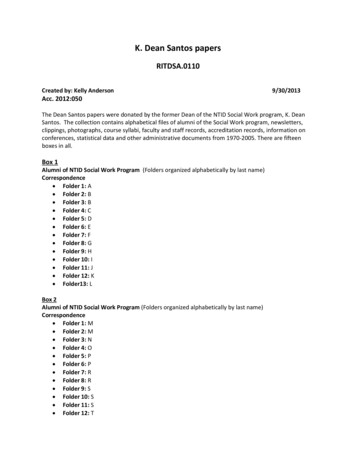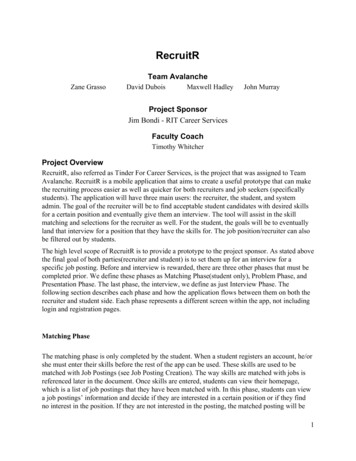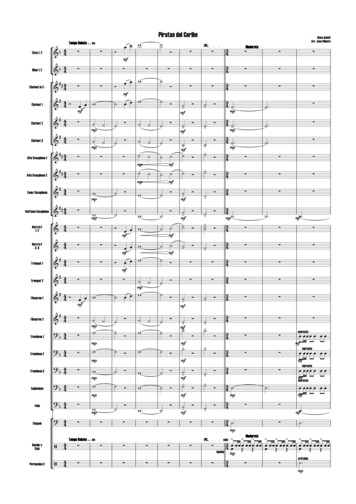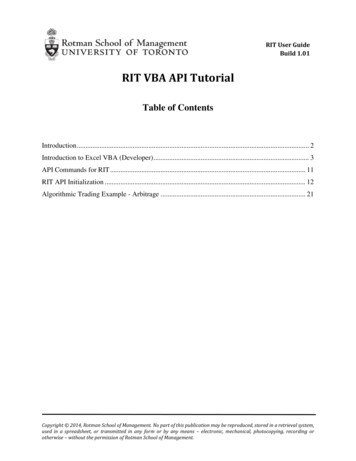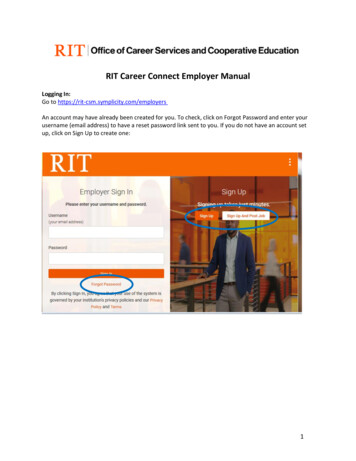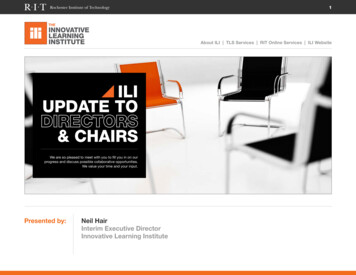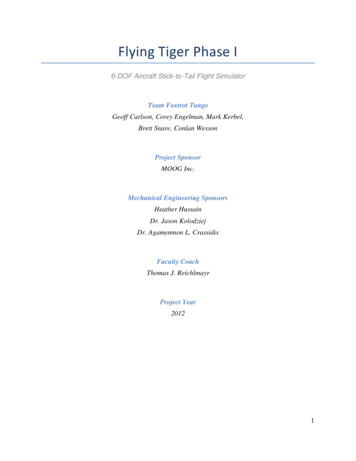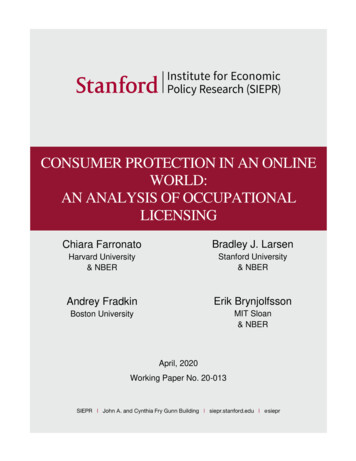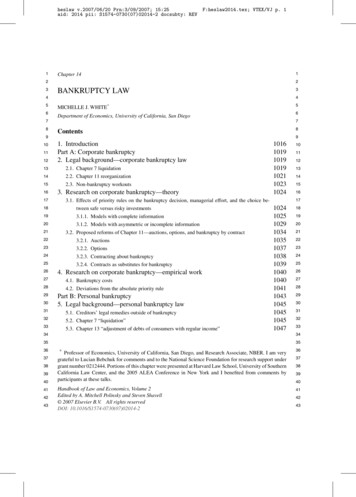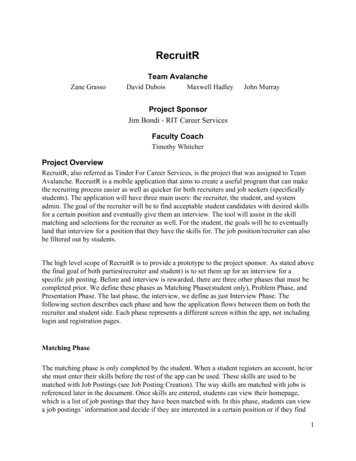
Transcription
RecruitRTeam AvalancheZane GrassoDavid DuboisMaxwell HadleyJohn MurrayProject SponsorJim Bondi - RIT Career ServicesFaculty CoachTimothy WhitcherProject OverviewRecruitR, also referred as Tinder For Career Services, is the project that was assigned to TeamAvalanche. RecruitR is a mobile application that aims to create a useful program that can makethe recruiting process easier as well as quicker for both recruiters and job seekers (specificallystudents). The application will have three main users: the recruiter, the student, and systemadmin. The goal of the recruiter will be to find acceptable student candidates with desired skillsfor a certain position and eventually give them an interview. The tool will assist in the skillmatching and selections for the recruiter as well. For the student, the goals will be to eventuallyland that interview for a position that they have the skills for. The job position/recruiter can alsobe filtered out by students.The high level scope of RecruitR is to provide a prototype to the project sponsor. As stated abovethe final goal of both parties(recruiter and student) is to set them up for an interview for aspecific job posting. Before and interview is rewarded, there are three other phases that must becompleted prior. We define these phases as Matching Phase(student only), Problem Phase, andPresentation Phase. The last phase, the interview, we define as just Interview Phase. Thefollowing section describes each phase and how the application flows between them on both therecruiter and student side. Each phase represents a different screen within the app, not includinglogin and registration pages.Matching PhaseThe matching phase is only completed by the student. When a student registers an account, he/orshe must enter their skills before the rest of the app can be used. These skills are used to bematched with Job Postings (see Job Posting Creation). The way skills are matched with jobs isreferenced later in the document. Once skills are entered, students can view their homepage,which is a list of job postings that they have been matched with. In this phase, students can viewa job postings’ information and decide if they are interested in a certain position or if they find1
no interest in the position. If they are not interested in the posting, the matched posting will beremoved from their homepage. If the student decides they are interested in the job posting, theyare moved on to the next phase within that job posting, the problem phase. The recruiter thatcreated the job posting can now see that the student is interested in the position within theirdashboard. The only information that is shown about the job posting in the matching phase, is theposition’s title, the name of the company, the location of the company, and the company’swebsite.Problem PhaseAfter a student selects that they are interested in a particular job posting, they are then moved onto the Problem Phase. The overview of this phase is that it a chance for the recruiter to providestudents with a problem, or problem statement, and give them a chance to answer/respond. Thisphase is not meant to provide a problem like you might see at a technical interview where youwould have to solve it to the best of your abilities, but more to introduce student with materialand issues that the position might deal with. On the other side, this gives recruiters theopportunity to review students’ responses to these problems and see what sort of experiencesthey have and how they can use their experiences to apply it in the positions environment.On this screen, students can view the problem statement. Once the statement is read, they thenwrite a response in the text field that is given to them. When the response is finished and ready tosubmit, the student submits the response. If the student feels they are not interested in theposition anymore after reading the problem, they have the ability to opt out of the specific jobposting. They will no longer be active on this posting and will not be able to view it. TheProblem phase is not the only phase in which the student can opt out. A student can opt out of ajob posting at any point of the process. As well as recruiters can decide they are no longerinterested in a student at any point. When a recruiter is no longer interested in a student, thatstudent is removed from the job posting and is notified.Once a student submits a response, the response is immediately sent to the recruiter for review.The recruiter then decides if they are interested in the student continuing in the recruitmentprocess. If the recruiter decides they are still interested, the student moves on to the next phase,Presentation Phase. If the recruiter is not interested after reading their response, the student isremoved from the job posting and is notified.Presentation PhaseIf a student has made it past the Problem Phase they are brought to the Presentation Phase. Thisphase is like the last, except instead of reviewing a problem and a response, a recruiter andstudent are reviewing a presentation. The student views a presentation of the company, that theCompany submits on company registration, therefore one company has one presentation, nomatter the job posting. A presentation can be in many different formats, including: video, slideshow, or a combination of the two.2
After the student has viewed the company’s presentation, they then have to decide if they are stillinterested in the job posting. If they aren’t they they are navigated out of the posting. If they are,then they must create a presentation to send to the recruiter. This presentation is meant to sell thestudent to the recruiter and help identify why they are right for this position. Again, thispresentation can be in many different formats. For the scope of this project we decided that allpresentations would be an embedded youtube video, so all students/companies would have to dois insert the link of the video. There is a time limit in which the student has to respond, with apresentation, or the job posting is automatically removed. (See Job Posting Creation). Once apresentation is created and sent off to the recruiter, they must wait until the recruiter decides ifthey are still interested in them. If the recruiter is still interested in the student after viewing theirpresentation, the student is moved to the next and final phase, Interview Phase. If the recruiter isno longer interested, the job posting is removed from the student and the student is notified.Interview PhaseStudents must have “passed” the last two phases in order to get to the Presentation Phase. This isthe final phase of the recruitment process and the goal of both the student and the recruiter; to getto this point. This phase is where both sides get to see more information about each other andone last glance before an interview date is committed. We also call this the reward phase becauseboth parties are rewarded in a certain way, in which we will explain below.Student’s RewardWhen a student makes it to this phase they are now able to see remaining information about thejob position that you would normally see on a job posting. Information like: position description,more detailed location, and recruiter contact information. Most importantly students are providedwith a view of interview time/date slots, in which they can choose a slot that works best for themto go and interview for that specific job position.At this Phase, students still have the opportunity to say they are not interested in the position andopt out, before they schedule an interview. If the student does decide they are still interested afterreading all the additional information about the posting, they must select a date slot in order forthe interview to be scheduled. Once a date slot is selected it is then removed from available, soother students can choose from the same slot, and moved to the students list of scheduledinterviews. An interview is now formally scheduled for that position.Recruiter RewardOnce a recruiter accepts a student from the Presentation Phase to the Interview Phase, they cannow see more information about the student. Information like their resume and contactinformation. They also see when the interview time and date is if the student accepts theinterview and chooses a time slot.Once the interview is scheduled the application functionality is over for that job posting. If3
interview times or dates need to be changed or there are cancellations, it is up to the two partiesto communicate with each other through the given contact information provided in this phase.The application will, however, remind both parties of a scheduled interview.Job Posting CreationA job posting is obviously only created by the recruiter. This is where a recruiter inserts all thenecessary components that are needed for the student to view throughout each phase (exceptpresentation; Company) . Each posting will need the following information: Position titleLocation of positionDescription of the positionRequired skillsRecommended skillsResponse timeoutProblem statementRequired skills are weighed more heavily than recommended skills when looking for studentmatches. This will be described more in depth in the design section (See matching algorithm).Response timeout is the amount of time a student has to respond in that phase. This timer will befrom days to weeks. If a student doesn’t respond by the specified timeout, they are automaticallykicked from the posting. This timeout is also include in the Interview Phase.Recruiter DashboardUnlike a student, the recruiter’s home page is the list of job posting that they created. They alsohave a dashboard, where they can also view how many students are in each phase of their jobposting. Each student’s information is kept confidential, until the interview. Other dashboarditems include editing a job posting and profile management.Student DashboardStudents also have a dashboard. Their dashboard includes categories like: interviews scheduled,job postings in progress, profile management, and skills management. Interviews scheduled arejob postings that the student has made it to the Interview Phase and have accepted an interviewand a time slot. Job postings in progress are the postings the student is currently in a phase with.Profile management is where a student can view and edit information about their profile;password, notification setting, graduation date, etc. Skills management is where the student cango in and add skills to their profile.User Registration4
Users that don’t have an account must register a new one. For students, they must provide theregistration screen with their school email in order to sign up. If the user does not have a schoolemail, they can not register as a student. Recruiters must provide the screen with their companyemail. If the company email is not in our systems database, then the company has to register (Seecompany Registration,.New Company RegistrationWe require that new companies have to be verified before recruiters can register and startmaking job postings. The reason for this is to prevent system abusers using the application totroll other users. For example, creating fake job postings. Whenever a new company registers, aapplication admin has to approve the company before anything else can be completed under thatcompany name.In conclusion, the overall application's goal is provide the sponsor with prototype of andIOS/Android app that streamlines the recruiting process and makes it more efficient. The endresult that both main users are striving for is getting an interview scheduled for a job posting.Basic RequirementsSystem FeaturesStudent login and profile managementThis feature allows a student to create and maintain a profile. Students can enter their contactinformation, skills, and preferences for what sort of jobs they want such as preferring largecompanies or preferring companies in coastal cities, and may upload their resume. They can alsoupdate this information as it changes over time.Functional Requirements: Students can create new profiles Profiles shall be identified by the student’s email address Student profiles shall always contain the student’s name, email address, school,anticipated graduation date, and skills; optionally phone number Students must upload their resume Students may add job preferences to their profile Students may change their job preferences, skills, school, graduation date, or name at anytimeRecruiter login and company profile managementThis feature allows recruiters to create and maintain profiles for their company. Company5
profiles have the company name, location(s), size, a brief description, and a presentation whichexhibits the company’s culture. Recruiters may edit this information at any time.Functional Requirements Recruiters shall be able to create profilesRecruiter profiles shall contain the recruiter’s name and company email addressRecruiter profiles shall be associated with one company profileCompany profiles shall have company name, location(s), size, description, link to ayoutube presentation about the company, and the domain of all emails used by recruitersof that company Recruiters shall specify a schedule with the times they are available to conduct interviewsAdministrator login and system managementThis feature allows administrators to create other administrators, approve or deny new recruiters,approve or deny new recruiters, and view statistics and reports about RecruitR.Functional Requirements Administrators shall be able to create a new administrator which includes a email,password, and usernameRecruiter job postingThis feature gives the recruiter the opportunity to post a job position that they would like to findstudents to potentially interview for. These postings contain all the information that a studentwould be able to see if they end up navigating through all the phases. The posting shall alsoinclude information on how long a student may spend at each stage before the student isconsidered to have been rejectedFunctional Requirements Recruiters can create new posting Recruiters must enter the name of the position, location of position, description ofposition, and the skills that are required and/or recommended Recruiters must enter the amount of time that a student may spend on each phase beforethe student is automatically rejected Recruiters must enter a problem statementStudent job matchingThis feature gives the student the ability to look through job postings that match their skills andopt into the application process with the companyFunctional Requirements: Student is matched with job postings automatically based on the intersection of theirskills and the required/recommended skills of the position Student can begin the application process with a matched job posting Student can view all matched job postings Student can sort matched job postings by most recent, most matched skills, location, and6
company sizeProblem phaseThis feature allows recruiters to tell student the sorts of problems that students will work on attheir company, and allows students to respond with project they have worked on that solve theseproblems, or to talk about how they might solve these problems.Functional Requirements Job postings shall have a list of problems or a problem statement that the student willeither be expected to solve or respond to while on the job Students shall be shown the problems while they’re applying for a job Students shall be prompted to respond with how they would solve these problems, orwith how they have solved these problems in the past Students shall create and submit a response Students shall submit a response Recruiters shall see the student’s response Recruiters shall either accept or reject a student’s responsePresentation PhaseThis feature allows students to view a presentation about the company they’re applying for,create a presentation about themself and their skills, and allows recruiters to view the student’spresentationFunctional Requirements The recruiter’s presentation shall be shown to all students who have applied for a job atthe recruiter’s company and who have passed the problem phase Students may accept or reject the recruiter’s presentation If a student rejects a recruiter’s presentation, the student shall no longer be considered tobe applying for the job The system shall record how many students reject an recruiter at the presentation phase If the student accepts a recruiter’s presentation, the student shall create a presentationabout themself and their skills The recruiter shall either reject or accept the student’s presentationInterview PhaseThis phase will be awarded to students who have been accepted through all phases by therecruiter. This phase includes the postings’ job description, a calendar where the student canselect a interview date and time slot.Functional Requirements Student must be able to view all of the postings’ information such as position title,company, description, location, and a calendar of available time slots for an interview A student must be able to select an open time slot from calendar A student must be able to view the contact information of the recruiter7
A student must have the ability to cancel an interview that has already been scheduledRecruiter DashboardThis feature will allow the recruiter to view all applicants for a job posting, as well as what phaseof the application process the applicant is at. The recruiter will be able to view notificationsabout the status of the job posting, such as actions needed and interview schedules.Functional Requirements: Recruiter will be able to view the name and phase of all applicants currently in theapplication process Recruiter will receive notifications on this page when an applicant reaches a stoppingpoint or interview for the job Recruiter will be able to view and edit the interview schedule Recruiter can cancel interviews Recruiter will be able to navigate to individual application steps for each applicant Recruiter will be able to sort applicants by name, phase, and most recent activity Recruiter will be able to view the resume of applicants in the interview phase Recruiter will be able to navigate to their profile and job posting management pagesStudent DashboardThis feature allows the student to view their scheduled interviews, job postings currently active,navigation to profile and skills management.Functional Requirements: Student must be able to view all active job posting they are interested inStudent shall be able to view all of their scheduled interviewsStudents shall be able to navigate to their profile and skill management pagesStudent can cancel scheduled interviewsConstraintsAs we hit the interim point of this project, reflecting back on the past semester, our team dealtwith numerous constraints. The first, and probably the biggest constraint was undefinedrequirements. Requirements gathering took a few weeks too many than expected and this islargely because there were undefined requirements. Going into the project the sponsor and histeam had a general idea of what they wanted to accomplish. Not having concrete idea on whatthe application must have lead to countless sponsor meetings where the majority of the time wasconversation and brainstorming requirements. A lot of the requirements were left to us, the team,to decide.Another constraint that the team encountered was Xamarin. Originally we were set to developour application through Xamarin native apps. Meaning, we would have to develop the UI8
separately for iOS and android. After 2 week of the team implementing separate UI’s, wedecided to switch from native to Xamarin Forms, which allows us to work on both UIsconcurrently. Though it took us a couple days to complete what we had natively, we still had theconstraint of last minute UI tool.One major constraint w
a job postings’ information and decide if they are interested in a certain position or if they find 1 . no interest in the position. If they are not interested in the posting, the matched posting will be removed from their homepage. If the stu
